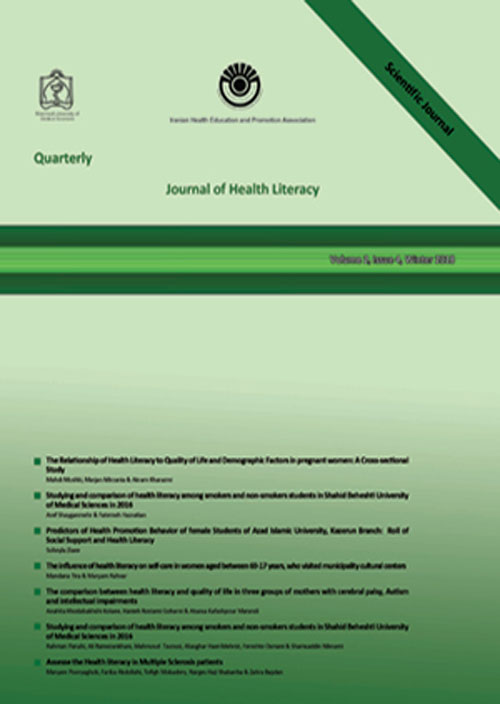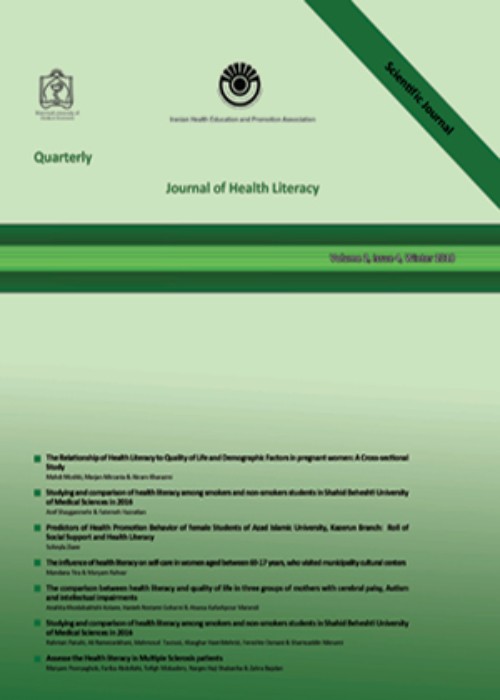فهرست مطالب

Journal of Health Literacy
Volume:5 Issue: 3, Autumn 2020
- تاریخ انتشار: 1399/10/01
- تعداد عناوین: 7
-
-
Pages 9-11Over the past decade, health literacy concerns have been a wake-up call for many areas of health. Recent studies about health literacy in recent years show that so far only a few studies have considered the design of tools or the measurement of specific health literacy that focus on issues such as oral health, risk factors for chronic diseases, breast cancer, Ear and Hearing. Over the past decade, health literacy concerns have been a wake-up call for many areas of health . A review of studies conducted in the country on health literacy in recent years shows that so far only a few limited studies have designed tools or measured specific health literacy that address issues such as oral health, risk factors for chronic diseases, breast cancer and Ear and Hearing . Regarding sexual health literacy, which is defined as personal knowledge, attitudes and beliefs, motivations and abilities in accessing, understanding, evaluating and using information related to sexual health, Researchers had access to only one study in the country, which was on tool design. On the other hand, the latest research in the field of sexual health in Iran shows that the rate of sexual dysfunction in Iranian men and women was relatively high and the participating women had Unfavorable sexual function.Keywords: Sexual, Health Literacy, Iranian Society
-
Pages 12-25Background and Objective
A person’s putting every behavior into practice after they receive information on health may mean that the person can exhibit the appropriate health behavior and protect his health within the context of their level of health literacy. This study was aimed at determining university students’ health literacy levels and the effects of their health literacy on their knowledge of, and attitudes and behaviors towards skin cancer prevention strategies.
Materials and MethodsThis descriptive study included 800 university students in the Aegean Region of Turkey. The data were collected by the researchers between March 01, 2019 and March 30, 2019. The research data were collected using the Descriptive Characteristics Form including 3 parts (the Participants' Socio-Demographic Characteristics Questionnaire, Information-Attitude-Behavior Questionnaire, Risk Factors Questionnaire) and the "Turkish Health Literacy Scale". The association between the sociodemographic characteristics of the students and their scores for protective behavior, knowledge levels and risk factors and Health Literacy was analyzed using the linear regression model (the ‘Enter’ method). The relationship between health literacy and knowledge/ attitude / behavior scores was evaluated with the Pearson’s correlation.
ResultsThe mean age of the participating students was 21.0 ± 1.8 (18-36) years. Of them, 63.8% were women. The study results demonstrated that the participating university students’ knowledge levels regarding the harmful effects of sunshine and skin cancer prevention were inadequate. There is a positive correlation between health literacy and sun protection attitudes and behaviors. Of the participating students, those whose health literacy levels were high and those who had high knowledge / attitude scores about sun protection displayed better sun protection behaviors (p <0.05).
ConclusionA significant result of the study was that health literacy should be improved in order to improve sun protection and skin cancer prevention strategies.
Keywords: University Student, skin cancer, sun protection, Health Literacy -
Pages 26-35Background and Objective
The global increase of the old population has changed into a crisis. The elderly' population low level of health literacy, introduced as a global issue in the 21st century, is considered as a common global problem. Health-promoting self-care behaviors are directly related to the health of the elderly and their quality of life by reducing the mortality and morbidity rates. Therefore, this study aimed to investigate the association between health literacy and self-care among the old population in Yazd, Iran.
Materials and MethodsThis cross-sectional study was conducted on 300 elderly people in Yazd. The participants were selected using cluster sampling method. The data collection tools included a demographic questionnaire, a researcher-made questionnaire over self-care behaviors, and Health Literacy for Iranian Adults' questionnaire. Data were analyzed by SPSS20 (SPSS, Inc. Chicago, USA) using descriptive and inferential statistical tests.
ResultsThe participants' average age was 66 years. The studied elderly people achieved 79.5% and 65.7% of the maximum attainable levels of the health literacy and self-care scores, respectively. A direct correlation was observed between the health literacy and self-care scores.
ConclusionRegarding the moderate level of self-care in the elderly people and its relationship with health literacy, appropriate educational interventions are required for the elderlies and their families in the field of health literacy. These trainings should be aimed to improve the old people' self-care and responsiveness with regard to various diseases by increasing their health literacy.
Keywords: Elderly, Health Literacy, self-care -
Pages 36-45Background and ObjectiveBreastfeeding is an effective way to protect and promote mothers and children's health. Two important factors that affecting breastfeeding success, are self-esteem and breastfeeding self-efficacy in women. The aim of this study was to investigate the relationship between self-esteem and breastfeeding self-efficacy in primiparous breastfeeding mothers.Materials and MethodsDescriptive cross-sectional multi-stage random sampling study conducted in 2014 on 300 primiparous breastfeeding mothers referring to healthcare centers of Mashhad, Iran. Data collection was performed by demographic form, breastfeeding self-efficacy Scale and Rosenberg self-esteem scale. Data were analyzed using descriptive, inferential statistics and general linear model through SPSS version 16.ResultsAbout demographic characteristics of participants, mother age (p= 0.001) and husband age (p < 0.001) and family income (p= 0.024) had a significant relevancy with self-esteem but infant age, husband education, residency and method of delivery weren't like that. And about relation with breastfeeding self-efficacy only method of delivery (p= 0.040) was significant. As well as, most mothers (79.3%) had high level of breastfeeding self-efficacy with a mean score of 131±13.60 and 78.7% of them had high level of self-esteem with a mean score of 27.85±3.54. Regression analysis confirmed the relationship between self-esteem and breastfeeding self-efficacy. According to the result by each score increasing of self-esteem score, breastfeeding self-efficacy score increased about 0.779.ConclusionAs the result indicated, maternal self-esteem is related to breastfeeding self-efficacy. These factors can help health care providers to predict length of breastfeeding, success rate of exclusive nutrition in mothers and can lead to the identification of mothers at the risk of the early breastfeeding cessation.Keywords: Breastfeeding, Self-efficacy, Self-Esteem, Primiparity
-
Pages 46-52Background and ObjectiveThe issue of quality of life in current century has become a real challenge, especially for the elderly. Spiritual health is considered the newest aspect of health and causes the integration of other aspects of health (physical, mental and social). The present study was conducted to investigate the spiritual health and quality of life of elderly people in Iranshahr, Iran.Materials and MethodsThis cross-sectional and correlational study was conducted among 377 elderly people in Iranshahr who were selected by available sampling. Data were collected by Paloutzian and Ellison’s Spiritual Health Questionnaire and Quality of Life Questionnaire (SF36). Pearson correlation coefficient, and analysis of variance were used to analyze the data. The SPSS software version 19 was used to manage the data.ResultsThe mean scores of spiritual health and quality of life of the elderly people were 88.98 ± 7.35 and 58.2 ± 6.2, respectively. The quality of life of elderly women was significantly lower than elderly men (p = 0.03) and there was a positive relationship between spiritual health and quality of life of the elderlies (p = 0.03).ConclusionAccording to the results of present study, it is necessary to consider the factors related to the quality of life in the care of elderly people. Also, the correlation between spiritual health and quality of life should be considered in the planning and policy-making related to health promotion of elderly population.Keywords: Spiritual health, Quality of life, Elderly
-
Pages 53-63Background & Objective
Developing new Information and Communication technologies has had a significant effect on all of science and knowledge area, including health science. Due to the large number of Electronic resources that product Health content, having health literacy for all of people in society is necessary and useful. This study aimed to identity E-health literacy among employees of state-owned Banks in Tehran in spring and summer of 2020.
Materials and MethodsThis is descriptive-analytical cross-sectional study. Statistical populations include 348 employees of 7 state-owned Banks in Tehran who were selected using sample size formula of Cochran and with a confidence level of 95%. Electronic Health Literacy Questionnaire used to collect data. The reliability and validity of the Persian translation of e-Health Literacy Questionnaire has been reviewed by Bazm et al .We also used Mean, Standard Subdivision, Mann-Whitney U, Kruskal-Wallis test and SPSS software (version 21) to analysis them.
ResultFindings show that E-health literacy of examined employees was more than average level and close to good place (30.61). "Level of Knowledge and cognition to Health resources available on the Internet" by the average of 4.07 was identified as the highest Indicator and "Level of Knowledge and cognition to way of searching and seeking health information resources in the Internet" were identified as the lowest indicator effect to E-health literacy of examined employees. Also findings show that there are significant different between E-health literacy and some Demographic characteristics like "Sex", "Degree", "Level of English Language Knowledge", and also "Level of Computer Knowledge" among examined employees (P <0.05).
ConclusionAlthough the E-health literacy level of the examined community is in a good condition; but Since the new health information and communication technologies in the web, internet and social networks increasingly are going to expanding, development of staff training knowledge and science with Learning information retrieval and information behavior skills by them, Caused to upgrade and improve of their E-health literacy knowledge and consequently Increasing their personal and social health will follow.
Keywords: Health Literacy, E- Health Literacy, Electronic health, Bank Employees, Banking Network -
Pages 64-73Background and ObjectiveHealth literacy exerts a positive effect on the improvement of self-management behaviors. Along with lifestyle, it is among the social factors affecting health. Self-efficacy is a predictor of health behaviors, including physical activity. With this background in mind, the present study aimed to determine the relationship between health literacy and regular physical activity self-efficacy with body mass index in adolescent girls aged 15-18 years.Materials and MethodsThis descriptive-analytical study was conducted based on a cross-sectional design in 2016-2017 academic year. In this study, 439 students were selected from Chenaran using multistage cluster sampling. Data were collected using demographic information questionnaire, health literacy questionnaire, and regular physical activity self-efficacy questionnaire and analyzed in SPSS software (version 16) using appropriate statistical tests.ResultsThe mean age of participants was reported as 16.51±1.03 years (age range: 15-18). The mean body mass index was 21.3± 3.64, and the mean score of health literacy was obtained at 0.78±0.93. The results also revealed that there was a significant difference between the mean scores of students' health literacy in the four levels of body mass index (p <0.0001). The self-efficacy of regular physical activity in obese and overweight students was lower, compared to that reported in students with normal BMI.ConclusionIn general, health literacy, physical activity self-efficacy, and body mass index in students were not optimal. This finding highlights the need for health education intervention programs based on the components of health literacy and self-efficacy.Keywords: Health Literacy, Adolescents, Self-Efficacy of regulate exercise, Body mass index


